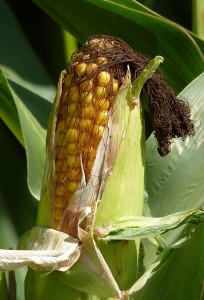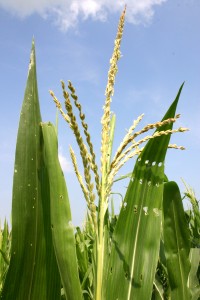Why Corn is Such a Miracle Food

The Magic of Ears of Corn: Appreciating Your Food
Corn, or maize, is a common staple of picnics and cookouts during the summer, but I was amazed to find out how little people knew about the biological "magic" that is corn.

In the US we use the word "corn" to refer to a very particular type of plant, specifically maize, or the tall plant with yellow compound fruits. Corn is in the family of Poaceae and with the monocots or grasses. Outside of North America "corn" can mean any grain crop. The fruit of corn is called a caryopsis or grain, and all corn plants have male and female parts. The male part (or inflorescence) is called the tassel, and it emerges at the top of the plant after all of the leaves have developed.

This tassel has many small branches, and along these branches you can see the male flowers and anthers, which produce pollen. The pollen is wind dispersed, and because it is relatively heavy it doesn't fall far from the plant, usually just on its neighbors and not itself.

The female inflorescence is the "ear" of the corn. The ear develops along the stalk, near the middle of the plant, growing from a leaf node. The immature ear of corn has a cobb, with many tiny ovaries that will develop into kernels after they are pollinated. The kernels are arranged in the familiar pairs of rows, which we enjoy eating. For each ovary/egg, a hair-like structure extends outward. This is the "silk" that we traditionally remove before eating. Each strand of silk will grow until it emerges from the top of the protective husk of leaves around the cobb. This cluster of silk is what we know as the tassel at the end of the ear. To have a full and tasty ear of corn, pollen must fall onto each and every single silk strand, so that the pollen can fertilize the ovules inside each ovary, lined up in rows, inside the ear of corn. The fertilized egg develops into a kernel, and inside each of the kernels is an embryo (the yellow triangular shape) that can develop into a new plant.
Kernel set is the term used to refer to how the kernels of the corn have developed on the cob. If you have ever pulled back the husk on an ear of corn, and have seen some parts of the cob that had no kernels, or sunken kernels, then ear had an incomplete kernel set. One cause of this incomplete set is if pollination was not completed for of every strand of silk. This may be caused by things like Japanese beetles that can clip the silk and prevent fertilization. Drought may also prevent the silk from growing in time to match the pollen shedding of the male tassels.
Incomplete sets can also be caused by the abortion of fertilized ovules. The ovules may be fertilized, and start to develop, but drought or other conditions may cause growth to cease. The tip, or top ovules, in an ear of corn are the last to be fertilized, and are usually less hearty than kernels along the rest of the ear. This is why, when you pull back the husk, you may see rows of shrunken kernels that look withered.
The optimal time to harvest corn is when it is in the "milk" stage. This is when the newly formed kernels have a high content of sweet sugary liquid inside them, which is called "milk." This milk is what makes a delightful squirt when you bite into the corn or poke it with a fork. If the corn was not harvested at the "milk" stage, when the kernel was full of liquid, then the liquid would be converted into a starch, which is a form of storage that the kernel/embryo/seed could used for developing into a new plant.
Ears of corn are a miracle of development and flowering. It blows my mind to think that each and every single kernel in an ear of corn had to be pollinated by the wind, with a tiny grain of pollen traveling down each and every strand of silk just to fertilize that one kernel that tastes so sweet. There's definitely a reason that many Native American cultures respected the "miracle of corn" and offered prayers with its pollen. Hopefully now, you too have a greater appreciation for the corn at your summer picnic, and don't forget the butter!

